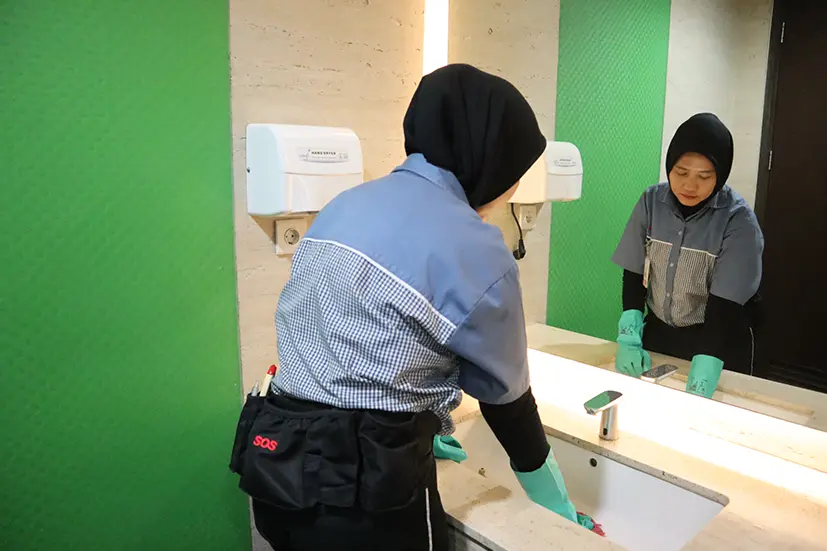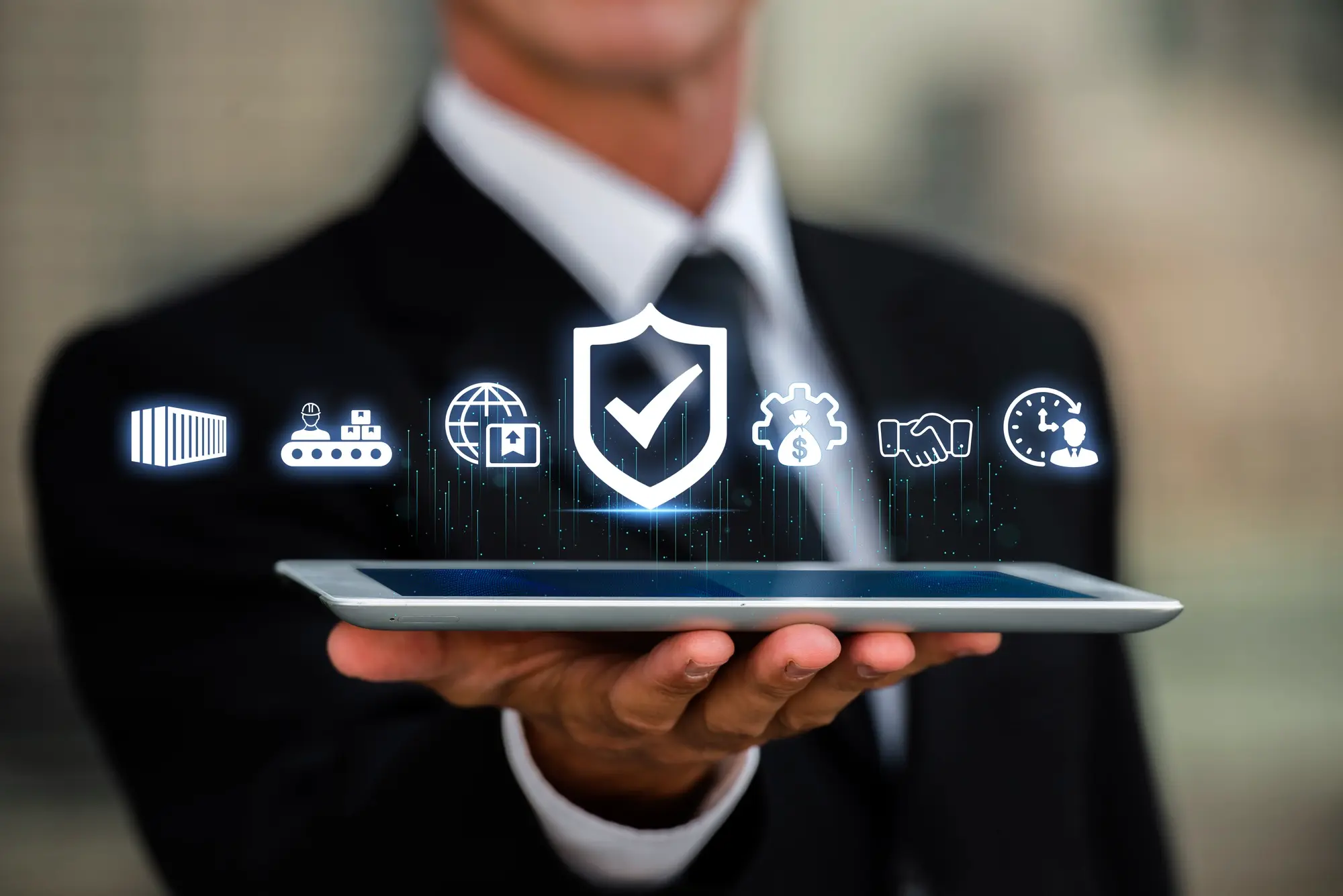SOP Toilet Cleaning Service Following K3 Standards
24 October 2025

The SOP toilet cleaning service plays a vital role in maintaining office cleanliness and professionalism. A clean restroom directly affects comfort and team productivity, making it crucial to understand standardized cleaning procedures that ensure a hygienic and efficient work environment.
Let’s explore how to create and implement a structured SOP for toilet cleaning below.
What to Consider Before Creating an SOP for Toilet Cleaning Service?
Before drafting an SOP for toilet cleaning service, ensure that every procedure aligns with the work environment and operational needs for consistent and effective results. Here’s what to pay attention to:
-
Determine cleanliness standards based on the type and usage intensity of the restroom.
-
Identify potential work hazards and ensure the application of K3 (Occupational Health and Safety) standards at every stage.
-
Prepare a checklist of required tools, materials, and personal protective equipment (PPE).
-
Establish a regular cleaning schedule based on office operational hours.
-
Set up a supervision and evaluation system to maintain cleaning quality.
Read Also: 12 Must-Have Cleaning Service Tools for Professional Cleanliness
How to Create an Effective SOP Toilet Cleaning Service for Office Hygiene?
Developing an effective SOP for toilet cleaning service requires a clear understanding of procedures, equipment, and each cleaner’s responsibilities. The goal is to ensure consistency, safety, and compliance with hygiene standards.
Follow these steps as a guide:
1. Define Cleaning Standards and Areas
Identify all areas included in the cleaning process, such as toilets, urinals, sinks, and floors. Each area requires specific attention according to professional cleaning service standards.
2. Prepare the Necessary Cleaning Tools and Materials
Ensure that cleaning staff use complete and safe equipment—such as mops, brushes, microfiber cloths, and non-abrasive cleaning solutions.
Using eco-friendly cleaning agents is considered best practice, whether in office restrooms or hospital environments that demand high hygiene levels.
3. Establish an Efficient Cleaning Sequence
Perform cleaning from the dirtiest to the cleanest areas. Start with trash disposal, followed by toilet cleaning, surface wiping, and floor mopping. This order ensures a more professional and hygienic result.
4. Apply K3 Procedures in Every Step
Safety must be a top priority in every cleaning activity. Cleaners should wear PPE such as gloves, non-slip shoes, and masks. Avoid mixing chemicals without proper guidance to prevent potential hazards.
5. Conduct Regular Supervision and Evaluation
Field supervision ensures all toilet cleaning SOPs are implemented consistently. Conduct periodic evaluations to maintain hygiene quality according to company regulations.
Read Also: Key Differences Between Deep Cleaning and General Cleaning
Example of SOP Toilet Cleaning Service for Offices
OFFICE TOILET CLEANING SOP
(TOILET CLEANING SERVICE OFFICE STANDARD OPERATING PROCEDURE)
Document Code: CS-TOI/003/2025
Prepared by: Cleaning Service Operations Division
Approved by: Housekeeping Manager
Effective Date: January 2025
Purpose:
To establish standard procedures for office toilet cleaning activities to achieve hygiene, comfort, and workplace safety according to professional cleaning and K3 standards.
Scope:
This SOP applies to all cleaning staff working in office restroom areas, both internal and outsourced personnel.
A. Preparation of Area and Equipment Before Cleaning
Before cleaning begins, staff must ensure the area and tools are safe and ready according to operational standards to prevent disruption and ensure efficiency.
1. Initial Area and Equipment Check
-
Ensure the toilet area is empty.
-
Inspect fixtures such as faucets, toilets, urinals, and ventilation.
-
Place a “Cleaning in Progress” sign at the entrance.
2. Required Tools and Materials
-
Tools: mop, brush, bucket, microfiber cloth, sprayer.
-
Materials: disinfectant, non-abrasive cleaner, air freshener.
-
PPE: gloves, mask, non-slip shoes, apron.
B. Toilet Cleaning Operational Steps
Toilet cleaning activities are carried out according to standardized work sequences to ensure maximum cleanliness and safety for cleaning staff. Each step below must be performed in order:
1. Trash Removal and Area Preparation
The initial step ensures the work area is clean from trash and safe for use.
-
Empty all trash bins and dispose of the contents in the designated waste area.
-
Check the toilet area for any debris or foreign objects that may obstruct cleaning.
-
Make sure the floor is free from spills or items that may cause slipping.
2. Sanitary Equipment Cleaning
This process focuses on cleaning main sanitary fixtures such as urinals, toilets, and sinks to maintain hygiene.
-
Apply a non-abrasive cleaner to toilets, urinals, and sinks.
-
Use the appropriate brushes: toilet brush for the bowl and microfiber cloth for outer surfaces.
-
Rinse with clean water to remove cleaner residue and ensure spotless surfaces.
3. Scrubbing and Rinsing Surfaces
This stage ensures all dirt, scale, and chemical residue are completely removed.
-
Scrub all water-exposed surfaces, including the base and sides of sanitary fixtures.
-
Apply moderate pressure to avoid damaging surface coatings.
-
Rinse thoroughly until no foam or residue remains.
4. Cleaning Touch Points
Areas frequently touched by users must receive extra attention as they are prone to bacterial spread.
-
Identify all high-touch areas, such as door handles, flush buttons, faucets, and toilet lids.
-
Spray disinfectant evenly on each surface.
-
Let it sit for a few seconds to effectively kill germs and bacteria.
-
Wipe dry with a clean microfiber cloth until perfectly dry.
-
Ensure no water stains or chemical residues remain after cleaning.
5. Floor Mopping and Drying
The floor must be cleaned systematically to remain safe and non-slippery.
-
Use a floor cleaner that meets office hygiene standards.
-
Start mopping from the farthest corner toward the exit.
-
Wring the mop properly to avoid puddles.
-
Let the floor dry completely before reopening the area for use.
6. Restocking Toilet Supplies
This stage ensures that all supplies are available and ready for use.
-
Check the availability of hand soap, tissues, and air fresheners.
-
Replace or refill supplies that have run out.
-
Make sure the soap dispenser is clean and tissue holders are properly installed.
-
Recheck the area to ensure no items are left behind.
7. Final Inspection of the Toilet Area
Lastly, ensure that all cleaning processes meet operational standards.
-
Conduct a visual inspection of all areas, including floors, walls, mirrors, and sanitary fixtures.
-
Ensure there are no water stains, cleaner residues, or odors left.
-
Test the functionality of all fixtures such as faucets, flushes, and lighting.
-
Store all cleaning tools neatly in their designated area.
C. Implementation of K3 Standards (Occupational Safety and Health)
K3 standards must be applied in every stage of toilet cleaning to protect workers and maintain service quality. Each cleaning staff member must follow these procedures under supervisor guidance.
1. Use of Complete PPE
Cleaning staff must wear gloves, masks, non-slip shoes, and aprons before starting work. PPE is used to protect against chemical exposure and injury during the cleaning process.
2. Control of Cleaning Chemical Use
Do not mix cleaning chemicals without technical instructions from the supervisor. Use solutions according to the label and dosage to ensure safety and prevent surface damage.
3. Ventilation and Air Circulation Inspection
Ensure proper ventilation to prevent exposure to chemical fumes. If the air circulation is inadequate, temporarily stop cleaning until the area is safe.
4. Reporting Damage or Unsafe Conditions
Immediately report any damaged facilities or tools to the supervisor. Avoid repairing on your own and record findings in the maintenance log sheet.
D. Toilet Cleaning Schedule and Frequency
Establishing a toilet cleaning schedule helps maintain hygiene and comfort consistently. The cleaning frequency should match usage intensity and office activity to ensure the restroom remains hygienic at all times:
1. Adjustment Based on Usage Intensity
High-traffic restrooms, such as in public areas or large offices, require more frequent cleaning than small offices. This adjustment maintains hygiene standards and prevents dirt buildup.
2. Daily Cleaning Schedule
Routine cleaning ensures the toilet stays hygienic and pleasant throughout the day. The recommended schedule includes:
-
Morning: Before working hours begin, ensuring the area is ready for initial use.
-
Midday: After lunch break, keeping the area fresh and odor-free.
-
Evening: Before office closing hours, ensuring the restroom is clean for the next day.
3. Cleaning Log Sheet Usage
Every cleaning activity must be recorded in a log sheet that includes the time, cleaner’s name, and inspection results. This document serves as proof of duty completion and as a quality control tool for supervisors.
E. Supervision and Performance Evaluation
Supervision and evaluation ensure that all toilet cleaning activities are carried out according to procedures and cleanliness standards:
1. Field Supervision
Routine inspections are conducted by the field supervisor or housekeeping manager to ensure compliance with the SOP. Each cleaner must follow instructions and report any issues encountered.
2. Visual Hygiene Evaluation
Visual inspections are performed on all toilet areas, including floors, walls, mirrors, sinks, and supporting equipment. This evaluation ensures that the area is truly clean, tidy, and odor-free.
3. SOP Compliance Monitoring
Cleaning staff compliance with the SOP is monitored regularly by the supervisory team. The results are used to assess SOP effectiveness and identify additional training needs.
4. Cleaning Report and Audit System
All supervision results are documented through daily checklists or digital reporting systems. The collected data becomes the basis for cleanliness evaluation and audits to ensure continuous service improvement.
F. Additional Notes
This section contains additional provisions to ensure the toilet cleaning SOP remains relevant and aligned with current operational needs. All updates must be planned and communicated to the entire team.
1. SOP Document Updates
The toilet cleaning SOP must be reviewed and updated at least once a year or whenever there are changes in work policies, operational methods, or cleaning products used.
2. Staff Training and Orientation
All cleaning personnel must undergo regular training to maintain up-to-date understanding of restroom cleaning SOPs.
The training program includes equipment usage, safety procedures, and hygiene practices according to K3 standards.
Read Also: 10 Essential Hospital Cleaning SOPs You Must Understand
A well-structured SOP toilet cleaning service following K3 standards is essential to maintain cleanliness, safety, and professionalism in the workplace.
To ensure consistent and effective implementation, companies can rely on SOS, a trusted Jakarta outsourcing provider, offering certified cleaning staff, regular training, and professional supervision systems.
Implement a Professional Cleaning SOP with SOS
Through its professional cleaning service outsourcing, SOS helps companies maintain clean restrooms and office areas in compliance with K3 standards.
With measurable work procedures and trained teams, every cleaning process is performed safely, efficiently, and with high quality.
What you’ll get:
-
Certified personnel with regular hygiene and safety training.
-
Strict on-site supervision to ensure SOP compliance.
-
Use of eco-friendly, user-safe cleaning products.
Contact us today for professional, safe, and customized office hygiene solutions for your company.



